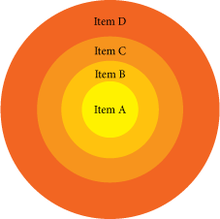| This article needs additional citations for verification. Please help improve this article by adding citations to reliable sources. Unsourced material may be challenged and removed. Find sources: "Onion model" – news · newspapers · books · scholar · JSTOR (April 2018) (Learn how and when to remove this message) |

The onion model is a graph-based diagram and conceptual model for describing relationships among levels of a hierarchy, evoking a metaphor of the layered "shells" exposed when an onion (or other concentric assembly of spheroidal objects) is bisected by a plane that intersects the center or the innermost shell. The outer layers in the model typically add size and/or complexity, incrementally, around the inner layers they enclose.
An onion diagram can be represented as an Euler or Venn diagram composed of a hierarchy of sets, A1...Ak (but perhaps potentially or conceptually infinite) where each set An+1 is a strict subset of An (and by recursion, of all Am where in each case m > n). (Some applications of the concept, however, may fail to benefit from the mathematical and otherwise rigorous properties of the model.)
Such formats supported by Microsoft PowerPoint's SmartArt wizard invoke the term "stacked Venn".
In business

An onion diagram is a kind of chart that shows the dependencies among parts of an organization or process. The chart displays items in concentric circles, where the items in each ring depend on the items in the smaller rings.
The onion diagram is able to show layers of a complete system in a few circles. Each of the circles is able to represent a component that is dependent upon the component on the inside of it shown by the circle inside of it. The main concept of the diagram is shown by the center circle of the diagram. This chart is used due to the fact that it has a clear visual representation that is easy to read, and it has a strong visual impact.
There is also the cultural onion which has seven layers to it including artifacts, behaviors, feelings, values, beliefs, worldview and ultimate allegiance. These layers organize a person's reality and life. The outer most layers are the most accessible while the in-depth ones are only accessible with connections to the person. The seven layers are integrated into three structural levels, which are the foundational, the evaluating, and the actualizing level.
In computing

The onion model in computing is used as a metaphor for the complex structure of information systems. The system is split into layers to make it easier to understand. A simple example is to start with the program, operating system and hardware layers. Each of these layers can then be subdivided.
See also
- Defense in depth (computing)
- Learning cycle § Levels of reflection
- Matryoshka doll
- Onion (Arendt)
- Social penetration theory § Onion model
- Start With Why § The golden circle
References
- Biafore, Bonnie (2004). Visio 2003 Bible. Indianapolis, IN: Wiley. p. 235. ISBN 0-7645-7294-6. OCLC 55217040.
- "Rainbow and onion diagrams". End Violence Against Women. Retrieved 17 October 2013.
- The Culture Onion
- https://www.slideshare.net/MdRokibulIslam2/mis-management-information-system-lecture-1
This systems-related article is a stub. You can help Misplaced Pages by expanding it. |